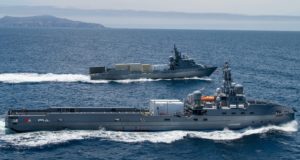
A total of four unmanned surface vessels sailed alongside crewed ships at RIMPAC 2022. The exercise took place on June 22, and allowed the U.S. Navy to share data and test out the AI capabilities of the unmanned ships to see how they would operate in larger fleets. Two of the unmanned ships that appeared were the USV Ranger and USV Nomad which form a portion of the Navy’s “Ghost Fleet.” Both ships are essentially unmanned seagoing flatbed trucks. Ranger and Nomad can carry active sensors like radars, and even weapons. Back in September, Ranger showcased its ability to launch SM-6 Missiles from a containerized four-pack SM-6 launcher on deck. Caitlyn Kenney of DefenseOne writes (abridged):
RIMPAC’s experimentation allows the Navy to test out and learn from the AI capabilities in its unmanned platforms, Adm. Mike Gilday, chief of naval operations, told Defense One last month.
“This exercise is helping us–at a classified level I can’t talk about–give us the ability to separate sensor from shooter, to exchange data between unmanned platforms in a way that we haven’t before. To leverage AI capabilities at the tactical edge in a way that we haven’t before.”
The conex boxes and the domes that stud the robot ships’ masts held a “various array of passive sensors” for intelligence, surveillance, reconnaissance, and targeting, said Cmdr. Jeremiah Daley, who commands Unmanned Surface Vessel Division One, the parent unit for Ranger and Nomad. The optionally manned ships can also carry active sensors, like radar, and even weapons, like the SM-6 missile that Ranger fired last September.
During the exercise, Nomad and Ranger set sail from Pearl Harbor under the control of an operations center in San Diego. Once at sea, they fed data from their sensors to nearby destroyers, Daley said. The goal is to create uncrewed ships that can operate essentially by themselves, while responding to the needs of the crewed ships nearby.
“We’re testing out how to combine that and make it to a point where it’s automated enough to be on its own, functioning, while still communicating with a manned platform from a command-and-control standpoint,” he said. “So that the manned platform is using the unmanned surface vessel as an extension of its own combat system.”
Daley also had two other fully uncrewed vessels at RIMPAC, Sea Hunter and Seahawk, each controlled by a destroyer crew who practiced navigating the smaller vessel and integrating its data with the ship’s combat systems. The destroyer’s crew was also improving the tactics, techniques and procedures for the ship, he said.



